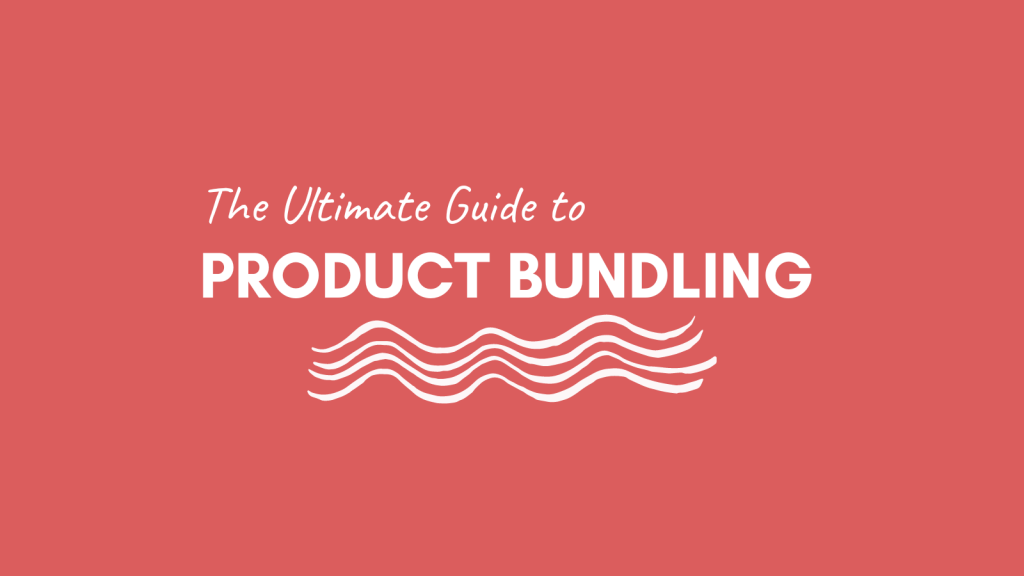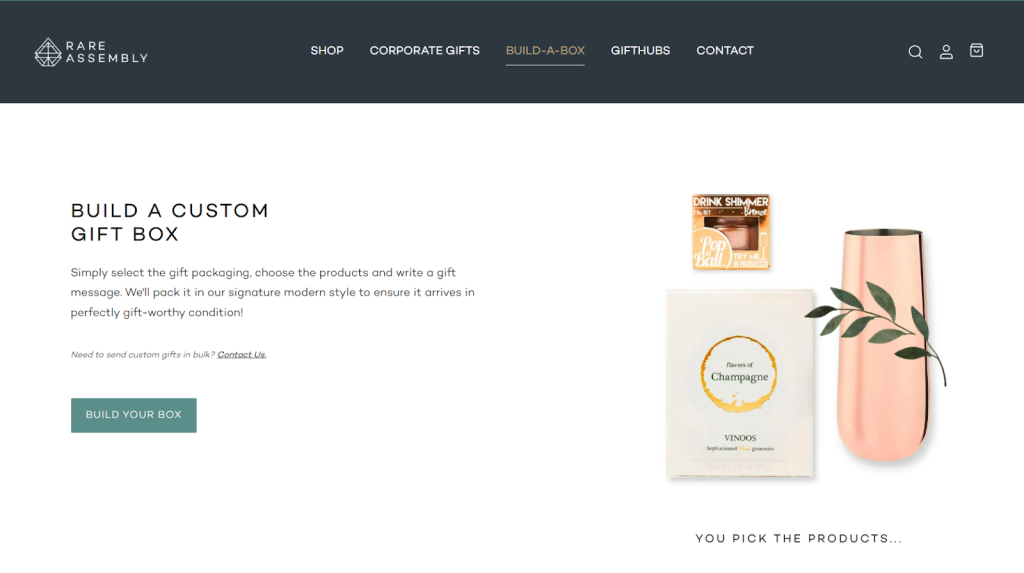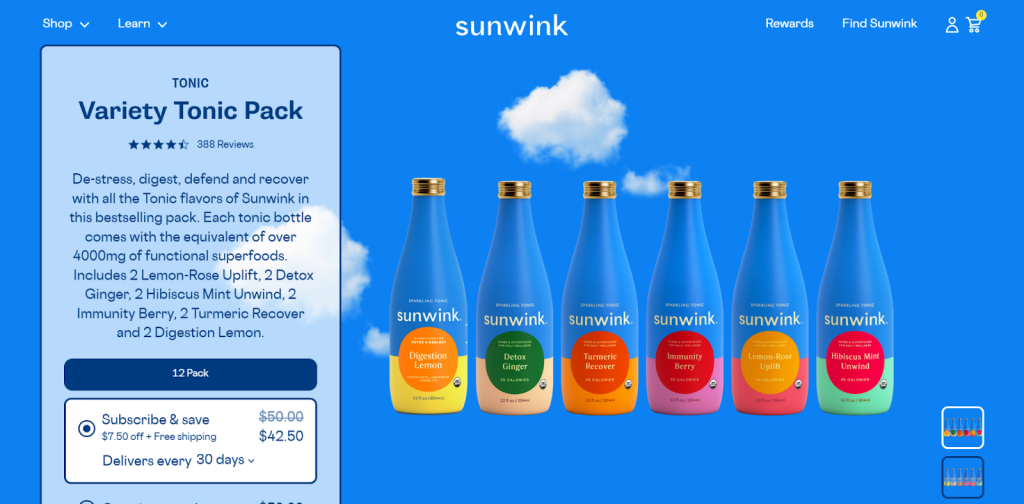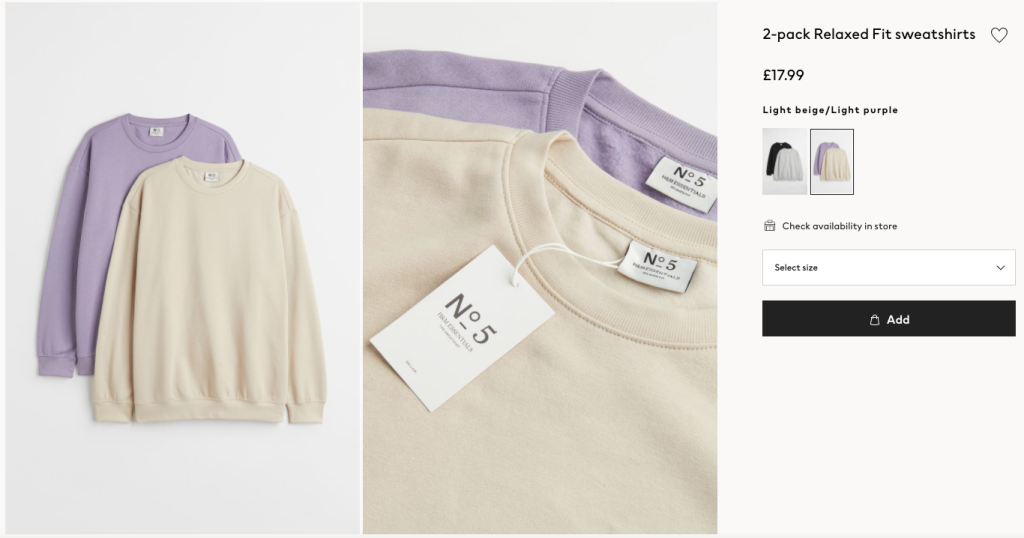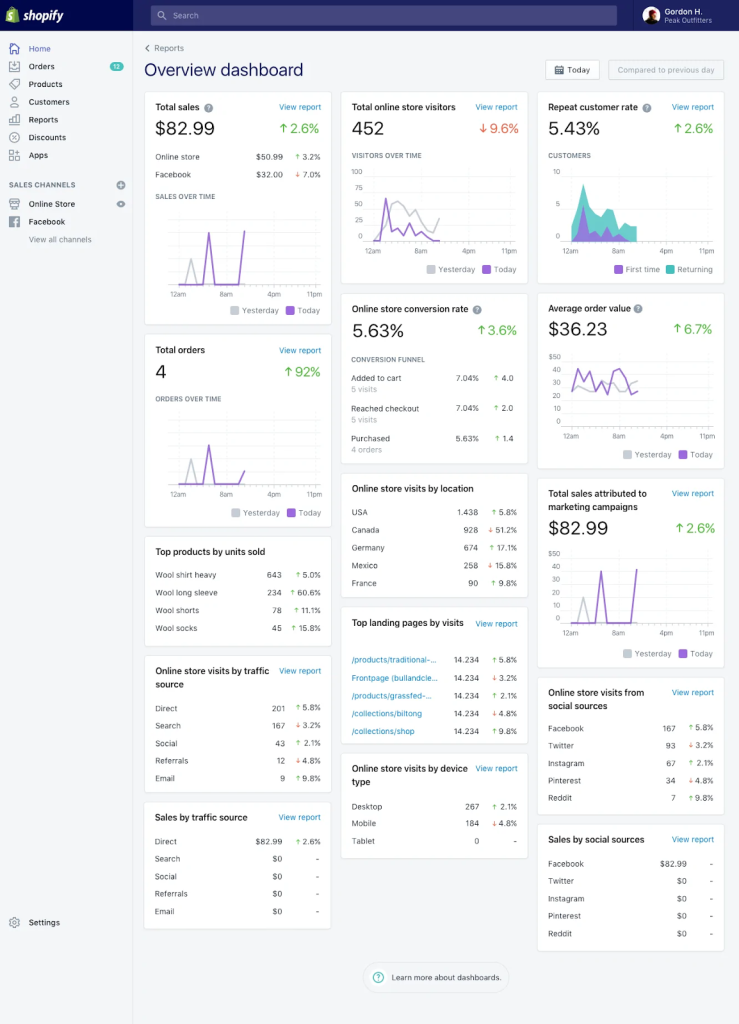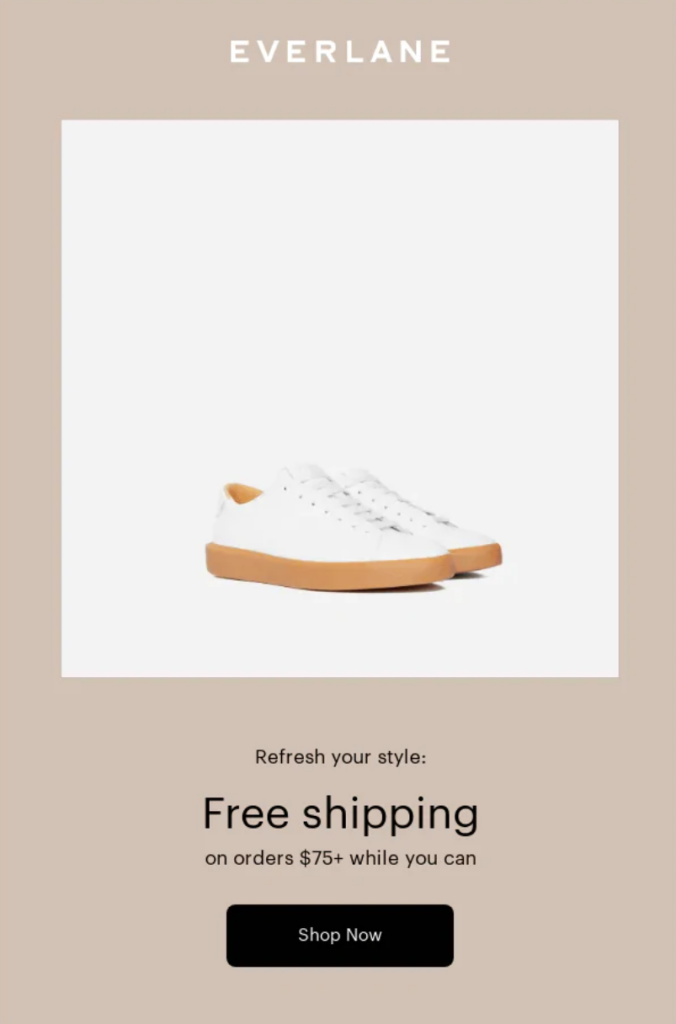Looking to boost your Shopify sales? Then you need to start bundling your products.
Bundling is an excellent way to offer your customers more value and encourage them to buy more from your store. Not to mention, it can also help you clear out excess inventory or promote slow-moving items.
In this guide, we’ll cover all that you need to know about bundling products on Shopify, including the types of product bundles, steps to set up bundles on Shopify, and tips for picking products and making the most out of your store. Let’s get started!
What is product bundling?
Product bundling is a marketing strategy that involves combining multiple products as a single unit for sale. The products may be related or unrelated, but they are typically packaged together for customers to purchase at a discount.
Product bundling is a popular way to increase sales and encourage customers to buy more than they would if they were buying each product separately.
Bundling can serve to reduce the “pain of paying” because it makes it harder for consumers to know what the “right” price is for the products.
Roger Dooley of neuromarketing
Bundling is much more than just putting products together — different products may require a different type of product bundling.
For example, some companies might choose to bundle their products by function. So, if you sell both skincare and makeup products, you could package them together as a “beauty bundle”. Other companies might prefer to bundle their products by price point. This means packaging together items that are all within the same price range (e.g., under $100).
7 types of product bundles in ecommerce
Bundling requires historical purchase data analysis paired with a little bit of intuition to put things together. Once you have a feel for what works, it becomes a lot easier to identify which products go best with another.
There are many ways to approach product bundling which can be overwhelming for a new store owner. To get you started, here are some of the most common types of product bundles.
1. Pure Bundles
Pure bundling is a bundling strategy in which the individual products that make up the bundle can be purchased only as a bundle, and not as standalone products. This technique limits the choices offered to the consumer making it easier for them to make a choice.
Businesses can also charge more for their product bundles here for two reasons:
- Bundling reduces the choices customers need to make while adding convenience to their lives
- Competing stores are likely selling individual products instead of bundling up, which means customers will not compare prices to find cheaper options.
One company that uses pure bundling successfully is HelloFresh.
HelloFresh is a cooking website that also sells recipe bundles. It combines all ingredients that customers need to cook a healthy meal, and offers meal options based on the number of people and recipes required each week.
This can be considered a pure bundling strategy because you cannot buy the ingredients individually — they need to be purchased as part of the bundle.
While this may seem like a negative at first glance, it’s actually positive for both parties involved — HelloFresh charges more per ingredient than if you were buying them individually from the grocery store (even taking into account delivery fees).
But customers are also willing to pay this premium price because they value the convenience and time savings of having a complete recipe delivered to their homes automatically.
In other words, by using pure bundling techniques, Hello Fresh provides its customers with added value that outweighs any potential negatives associated with being locked into one purchasing decision.
Pros
- The main advantage of pure bundles is that they can encourage customers to purchase products or services that they might not have considered otherwise.
- Another advantage of pure bundles is that they can simplify the purchasing process for customers. For example, a customer who is looking for a cell phone plan that includes a certain amount of talk minutes, text messages, and data per month can easily find and purchase a pure bundle that meets their needs.
Cons
- One of the main disadvantages of pure bundles is that they can be inflexible for customers. In the case of HelloFresh, if a customer does not need all the ingredients, they may have to look outside to buy the ingredients individually.
2. Customizable Bundles
Customizable bundling allows customers to choose among multiple products to create a bundle. This is mostly done by brick-and-mortar stores for fast-moving consumer products such as perishables or bulk items. However, you will also see this on ecommerce sites.

Here, you specify a few products for your customers to choose from and they can create their own custom bundle from the options available.
This method helps the customer feel that they’re in direct control of what they want to buy, thereby increasing the perceived value of the item. It’s the perfect method for encouraging your customers to buy products in bulk without forcing them to buy items that don’t interest them.
For example, Rare Assembly is a store that only sells bundled products. But it allows customers to choose from the different products available for bundling.
This can help customers build personalized gifts. For example, you can create a bundle of makeup items and specify that the customer can choose any 3 products to include in the bundle.
Creating such product bundles on Shopify is easy with BoxBuilder. It helps you easily create custom bundles or packages to sell in your store.

The customizable bundling technique is beneficial for both the customer and businesses because it allows customers to feel like they are in control while still giving them a discount for buying more items. This encourages them to buy products in bulk, which saves businesses money on packaging and marketing costs associated with individual items.
Pros
- The main advantage of customizable bundling is that it allows businesses to offer discounts on products without seeming too pushy.
- This technique also helps businesses move slow-moving inventory by packaging it with fast-moving items.
Cons
- One of the main disadvantages of customizable bundling is that customers might not want to buy all the products in a bundle, which means they’ll either have to go through the hassle of returning some items or pay for items they don’t need.
- Another disadvantage is that this technique can be confusing for customers if there are too many choices available.
Try BoxBuilder to add customizable bundles to your Shopify store.
3. Buy One Get One
The “buy one, get one” (BOGO) bundling strategy is one of the most common bundling strategies out there – especially seen in the ecommerce space.
When customers purchase the main item, they receive a discount or a complementary product. It’s an easy way to sell more products, increase your AOV, and give customers more value for their money too.
Dominos is the perfect example of this bundling strategy. They regularly offer BOGO on their products and BOGO deals attract more customers than other bundling strategies out there.
Pros
- BOGO bundles help you clear out inventory. This is especially beneficial if you have products that are nearing their expiration date or are seasonal items that won’t be needed in the near future. By selling two of these items at a time, you ½ the time required to clear the inventory.
- With BOGO, customers feel like they’re getting a deal when they purchase a bundle of items, even if the individual prices aren’t discounted by a lot. This can lead to higher sales and customer satisfaction overall.
Cons
- You need higher margins to enable proper BOGO offers. In the case of Dominos, they have higher margins or are averaging out the revenue across all orders to execute their regular BOGO deals.
- Customers can get used to buying two at the price of one and it may become difficult to switch to selling single products again.
4. New Product Bundles
New product bundling is a promotional technique in which businesses group newly launched products with existing or popular products, in order to encourage customers to discover and try the latest offering.
The logic is that people are likely to purchase a new item if it’s offered bundled with a product they already need.
The Body Shop does it especially well by highlighting new products prominently. The NEW tag catches the attention of user scrolling through the collection pages — thus bringing in people to the product page.
Once the users try all the products in a bundle, they’re more likely to purchase them again next time.
New product bundling can be an effective way to increase sales and boost exposure for your business, but it is important to carefully consider the products that you include in a bundle as well as the pricing strategy that you use.
Pros
- Grouping together existing or popular products with a newly launched item, you are more likely to catch people’s attention and interest them in trying out the latest offering from your company. This technique can also be used as a way to introduce customers to other products that they may not have considered before, broadening their horizons and increasing the chances of making future purchases.
- A great way to build relationships with other companies while also expanding your reach into new markets. Additionally, partnering with another business allows you to tap into their customer base, which could lead to increased sales down the line.
Cons
- Requires thorough market research to understand if a new product is complementary to the product it’s paired with. If you force an unrelated product with something customers want to buy, it may end up putting them off.
5. Pack bundles
Pack bundles are products that are sold together in a package. This could be anything from a bundle of clothes to a set of books. The advantage of selling products in a pack bundle is that it can save the customer money on shipping costs and also make it easier for them to find everything they need in one place.
It is also a great way to promote products that go well together. For example, if you sell clothes and accessories, you could create a pack bundle that includes a top, bottom, and scarf. These bundles can also be called as shop-the-look bundles — a common term in the clothing industry.
An example of pack bundles is Sunwink. Sunwink is a line of health-conscious beverages that come in six different flavors: detox ginger, turmeric recover, hibiscus mint unwind, digestion lemon, lemon rose uplift, and immunity berry.
Sunwink sells a 6-pack bundle on their website for $50. The six-pack includes all six flavors of Sunwink. This is a great deal for customers because they get to try all the different flavors and save money on shipping costs.
Pros
- Saves the customer a lot of money on shipping costs. When products are sold together in a bundle, they can be shipped together which saves on packaging and shipping costs. This is especially beneficial for customers who live far away from the store or if the store offers free shipping for orders over a certain amount.
- Makes it easier for customers to find everything they need in one place. This is especially helpful for customers who are looking to buy multiple items that go well together such as clothes or books.
- A great way to promote complementary products. For example, if you sell clothing and accessories, you could create packs that include tops, bottoms, and scarves. These types of bundles allow stores to showcase how their products can be worn together and give customers ideas on how to style them. This can be very helpful for shoppers who are unsure about what goes well together or how to put an outfit together.
Cons
- Customers may not want all of the products in the bundle. For example, if you sell books and someone only wants one book, they would have to buy the whole bundle even though they only need one item.
6. Discounted bundles
Discounted bundles can encourage online buyers to purchase more products or opt for bundled products to take advantage of the discounts. There are several ways businesses can go about creating bundled discounts.
For example, a clothing store might create a bundle of summer clothes including shorts, t-shirts, and sunglasses. Or pair up different colored clothes together at a discount.
In addition to offering savings on the total purchase price, discounted bundles can also help increase average order values (AOV).
Customers who take advantage of bundled discounts typically spend more per transaction than those who do not because they feel like they are getting more value for their money.
Pros
- Discounted bundles are effective for increasing sales and revenue. By carefully selecting products that complement each other, businesses can create bundled discounts that offer significant savings without sacrificing profitability.
- More enticing offers for customers, helping with brand recall and recognition for your customers
Cons
- Offering too many different discounts (such as a percentage off and free shipping thresholds) can become confusing for customers and make it difficult for them to make a decision.
7. Inventory clearance bundles
Inventory clearance bundling is a technique where ecommerce stores pair a faster-moving item in the inventory with a stagnant or slower-moving item to clear inventory space and decrease their inventory holding costs.
This method includes discounts on your bundles so that shoppers who are interested in a top-selling item will see the whole bundle as a bargain and will be more inclined to buy it.
For example, if an online retailer has several products that aren’t selling well but they need to make room for new stock, they might create an “inventory clearance” sale that offers significant discounts on those items. Or, if a store has too much of one product and not enough of another, they might bundle the two products together at a discounted price in order to move both items more quickly.
Pros
- Helps ecommerce stores clear out old or unwanted inventory quickly without resorting to drastic measures like dumping everything at rock-bottom prices (which can damage brand image).
- By offering bundled deals at reduced prices, stores can attract customers who may not have considered buying the individual items before; these customers may then become regular buyers even after the sale is over.
- Can be cost-effective as most clearance sales are shared via word of mouth.
Cons
- If not done carefully, it can create an impression that a store is desperate to get rid of certain items. For example, if a store offers too many deep discounts on slow-moving items, shoppers might start to wonder why those items are selling so slowly in the first place.
- This could lead to customers only buying products when they’re on sale. If a customer knows they can always wait for a clearance sale before making a purchase, they may be less likely to buy anything at full price (even though some individual items may never go on sale).
Benefits of product bundles for ecommerce success
Now that you know the different types of product bundles, let’s look at some of the major benefits of product bundling. If you
There are several benefits to product bundling, including
- Increased average order value: When customers buy multiple products in a bundle, they typically spend more money than they would if they were buying each product individually.
- Efficient inventory management: As more products go off the shelves quicker, you can better manage your inventory and predict how long before you need to restock. And once you identify a bundling strategy that works well for your customers, it can become even more efficient to clear old inventory while staying profitable.
- Increased customer satisfaction: Customers are often happy to receive a bundled product because it represents a good value. Bundled products can also make it easier for customers to find everything they need in one place.
There are also some drawbacks to product bundling, including
- Less customer choice: When products are bundled together, customers have less choice in what they purchase. This can lead to customers being less satisfied with their purchase.
- Increased price: The price of a bundle can sometimes be higher than the price of the individual products, which can lead to customers being less likely to purchase the bundle.
When using product bundling as a marketing strategy, it is important to consider the benefits and drawbacks of product bundling. The best way to use product bundling is to offer a variety of bundles at different price points. This will give customers the choice to purchase the bundle that best meets their needs.
How to create bundles on Shopify with BoxBuilder?
Creating bundles on Shopify is super simple with BoxBuilder. Simply install the app and set the bundles in 4 steps.
Been using this app for several months now. It’s been really easy to set up and use! The tech support team is really helpful and responsive. Keep up the good work guys. Highly recommended!
Essuli
Step 1: Choose the type of bundle builder
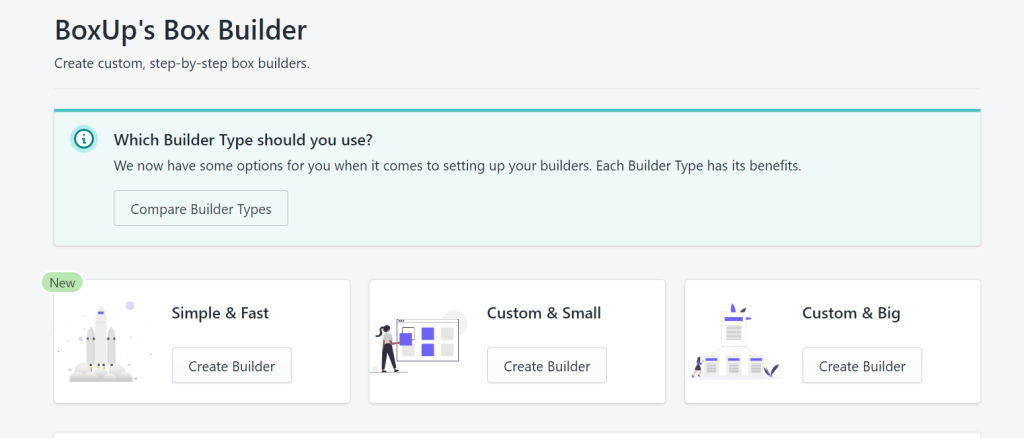
BoxBuilder has three types of bundle builders — simple and fast, custom and small, and custom and big. Here’s a quick comparison between the three types of bundle builders to help you choose.
| Feature | Simple & Fast | Custom & Small | Custom & Big |
| Loading Speed | Fast | Slower | Medium |
| Can add products using a collection | Yes | Yes | No |
| Can add individual products | No | Yes | Yes |
| Recommended Product Limits | Unlimited | 50 | Unlimited |
| Can show hidden products | No | No | Yes |
| Can edit the liquid code | Yes | No | No |
For this example, let’s go with Simple & Fast. Click on the Create Builder button under the type of bundle builder you want to use.
Step 2: Setup the bundle builder
Now, you’ll be taken to the bundle setup screen. Let’s start by entering the details for your bundles.
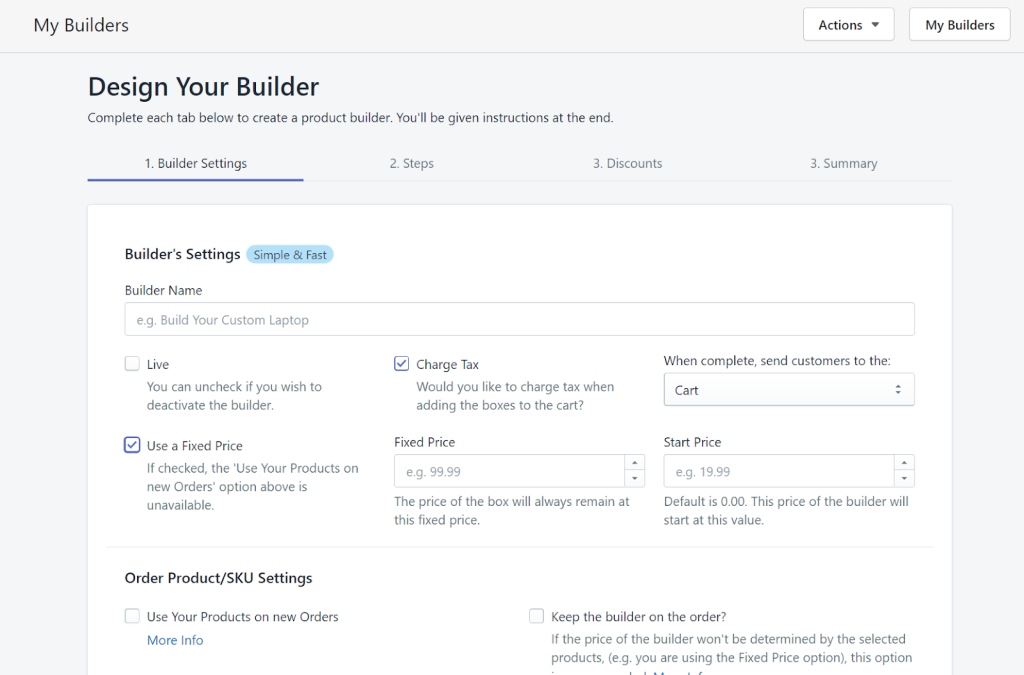
Enter the bundle name and the pricing for your bundle. Also, select if you want to charge tax on the bundle price.
Continue to edit the rest of the options for your bundle including:
- how the products are displayed
- If you want customers to be able to zoom in on images
- Display or hide prices
- And more…
Also, choose how the bundles will appear to your customers — full width or fixed on the right side.

Once done, click Next to proceed to step 3.
Step 3: Add custom steps to bundle creation
Let customers choose the products they want to add to their bundles (think customizable bundling).

- Add the number of products that customers can choose per bundle.
- Then pick one or multiple collections for customers to pick products from.
- Once done, click Save Step which will show you the summary of all the steps you’ve added.
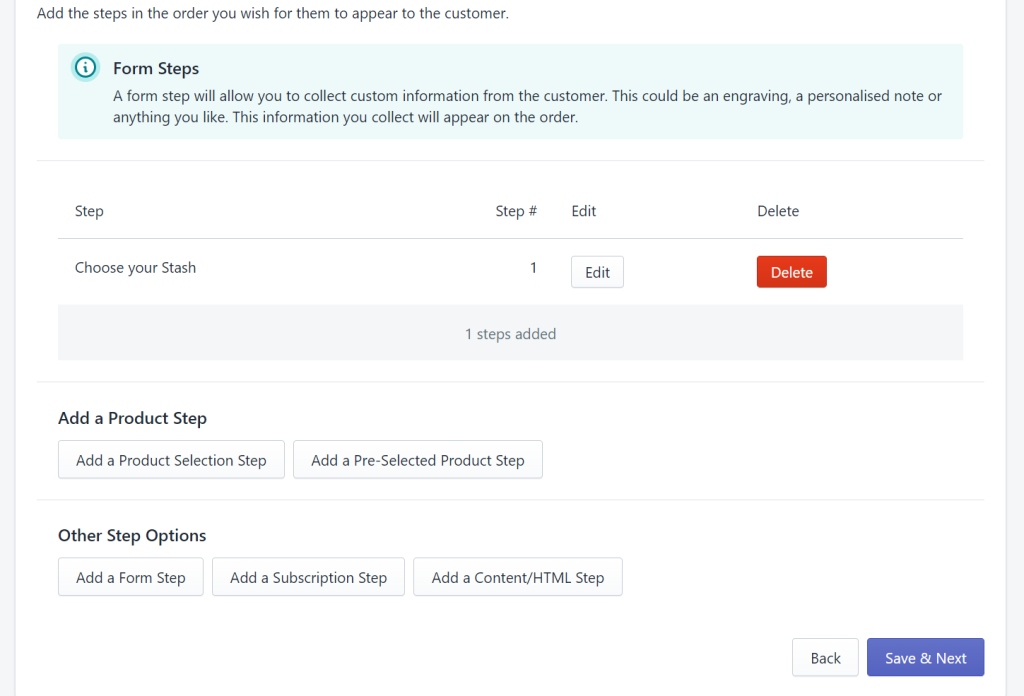
- Continue to add more steps including forms, subscription pages, individual products, and more as required.
- Once you’ve added all the required steps, click Save & Next.
The next one is the final step of creating bundles — adding discounts.
Step 4: Discounting bundles
The main incentive for customers to purchase bundles rather than individual products is generally for the discounts.
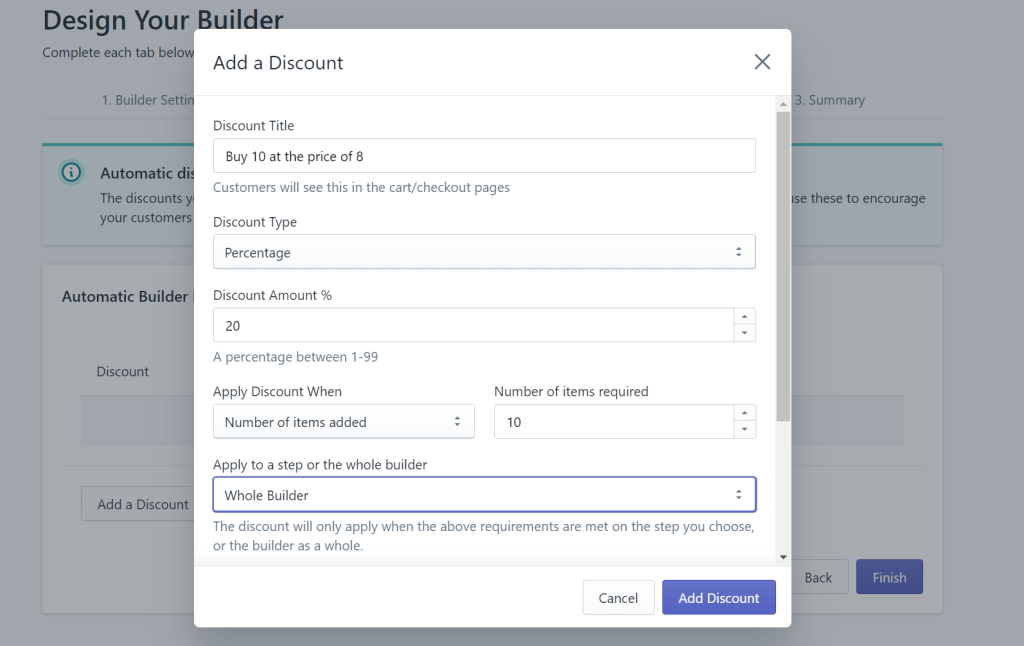
- Click Add a discount
- Customize the discount for your bundle including the percentage, when the discount is applied, product or cart value threshold, and more.
- Once you’ve set it all up, click Finish and your bundle will now be live!
If you want to edit the steps of your bundle later, you can always go to the BoxBuilder dashboard and edit the bundle all over again.
4 steps to picking winning products for bundling
When it comes to bundling, the product choices in the bundle matter a lot. Getting the right combination of products can mean the difference between customers lining up to buy the bundle or letting it be completely ignored.
Here are 4 steps to pick the best products for bundling together.
1. Dig into the purchase history to find items commonly bought together
Start by exporting all your purchase data as a CSV or excel file. Then begin to sort and filter the data by sales revenue and total sales, to identify see which products are commonly bought together.

Alternatively, market research tools like Survey Monkey or Qualtrics can help you get direct insights from your customers on what products they generally pair up when purchasing.
Surveys are the most powerful way to get real-world data right from your ideal customer profile (ICP). You don’t need to do traditional survey forms. Get your best customers on call, pay them a fee for their time or buy them a coffee to spend time with you. Record the meetings, and get the insights from those conversations.
Ninad Pathak, Fractional Content Marketer, Staytuned
Once you have a list of potential product bundles, you’ll need to consider how much each bundle will cost and whether it represents a good value for the customer.
You should also make sure that the products complement each other well and that there is not too much overlap between them.
2. Determine the top-selling products in your store
There may be some items that are bought more frequently than others, regardless of what else is in the purchase. These items could make good candidates for bundling since more customers are interested in them overall.
To find these items, you can again sort and filter your data according to the frequency of purchase. Alternatively, you could look at sales data to see which products are selling well overall. Either way, you’ll want to consider cost and customer value when deciding which products to bundle together.
3. Find items that have a high margin or are high-ticket items.
Bundling together items with a high margin or that are high-ticket items can be a good way to increase profits. Customers may also be more willing to pay a higher price for a bundle that includes these types of items.
To find potential products to bundle, you can sort your data by margin or price. You could also look at sales data to see which products have the highest revenue. As before, make sure to consider cost and customer value when deciding which products to include in a bundle.
4. Brainstorm items that would logically go together.
You may be able to come up with potential product bundles just by brainstorming items that would logically go together. For example, you could bundle together a book and its accompanying study guide or a winter jacket and a scarf.
You can also implement the shop-the-look feature which will help reduce the decisions your customers have to make before making a purchase. Once you have a few ideas, research the cost and customer value of each bundle to see if it is feasible and worthwhile.
How to promote your product bundles
If you’re looking to increase your sales and revenue, promoting bundles is a great way to do it. Offering multiple products at a discounted price can attract new customers and convince existing ones to buy more from you. But how do you effectively promote bundles?
Use Social Media
Social media is one of the fastest ways to get your products and product bundles in front of the right people.
LoveSeen leverages Instagram to promote its products to its 32,000+ followers. While they’ve already grown their following enough, here are some common tips for you:
- Plan out your product photo styling. Keeping it all very in tune with each other will help you create a brand personality.
- Regularly answer queries that you come across while browsing through your feeds. Customers who haven’t seen your brand are more likely to follow you if you add value by helping them out.
- Host Instagram celebrities or industry experts to answer tough questions related to your industry. This will automatically merge your brand’s and the influencer’s audience.
Design sticky content
Social media is a short-term channel. The posts you make today are unlikely to make an impact tomorrow or the day after. So while you work on gaining traction through short-term channels, you also need to create long-term assets through content creation — aka evergreen content.
Taking the LoveSeen example further, you can see they have short writeups with embedded videos as their blog articles. This type of content:
- Sticks around longer — People are regularly looking up these terms on Google or YouTube. Getting your brand to show up in their search results is an excellent way to grab attention.
- Scales traffic over the long term — Consistently creating such content can help you attract more and more people over a long period of time. A lot of businesses start with paid ads and over a period of 1-2 years, reduce their paid ads to $0 as the organic traffic breaks even for free.
- Builds authority — Depending on the type of industry, you can create guides, videos, ebooks, or other content assets that will automatically build your brand authority for users looking up answers. Once someone watches a long-form video from your brand, they’re more invested in the brand than someone who came to you from a social media image.
Overall, having a content machine that generates leads should be your focus as your brand grows and you’re looking for long-term sustainability.
Use Paid Advertising
Paid advertising is the quickest and most effective way to promote your product bundles. However, the key to paid advertising is to target the right audience and use persuasive copywriting.
While the subject of audience targeting is out of scope for this article, there’s one thing you should absolutely do — go as specific as you can to target based on the demographics like age, location, and interests. As you test more ads, you’ll find your best audience — the one that has a higher conversion rate overall.
The main benefit is lower customer acquisition costs (CAC). With a smaller total addressable market, your ad costs will be lower too thus giving you access to more customers with lesser ad spend.
Once you have your target audience narrowed down, it’s time to start writing your ad copy. Your headline should be attention-grabbing and persuasive. The body copy should be clear and concise.
And finally, your call-to-action must tell people exactly what they need to do next (e.g. “Download the guide”, “Buy at discount”, etc.). You can find a lot of copywriting examples for inspiration here.
Create an Email Marketing Campaign
Email is one of the most powerful channels for marketing. It’s personal, it’s direct, and it’s easy to track. You can use emails to drive traffic to your product pages or even better, your bundle pages.
There are two types of email campaigns you can use to promote your product bundles:
1. Prospecting Email Campaigns
A prospecting email campaign is when you email people who don’t know about your brand yet. These can be people who subscribed to your newsletter or people who you bought an email list from.
With prospecting email campaigns your main focus is to make emails land in the inbox and not the spam folder. You can do this by keeping your email short, sweet, and to the point. There’s a lot of science behind getting your email deliverability high, improving your open rates, and more. If you’re new to email marketing, do check these tips by Hubspot on email deliverability.
2. Remarketing Email Campaigns
A remarketing email campaign is when you email people who have already interacted with your brand in some way. This could be people who have visited your website, abandoned their cart, or subscribed to your newsletter.
The key to remarketing email campaigns is to personalize the email and make it as relevant to their initial visit as possible. Suppose the person visited a makeup product page — you need to send an email that suggests makeup products.
Both prospecting and retargeting email campaigns can be effective in promoting your product bundles. It’s important to test different tactics and see what works best for your business.
Run Promotions or Contests
People love getting a good deal and they also love winning things. You can use this to your advantage by running promotions or contests where people can win your product bundle.
There are a few things to keep in mind when running promotions or contests:
- Create prizes that people actually want. This seems like a no-brainer but you’d be surprised how often businesses give away prizes that no one cares about.
- Keep the entry requirements easy to complete. The last thing you want is for people to start your contest and then give up because the entry requirements are too difficult.
Keep promotion or contest relevant to your brand. This is your chance to promote your brand and get people talking about you. Don’t let the competition sway away from your brand messaging in an attempt to grab more attention.
Leverage the power of affiliates
If you have an existing customer base, you can use them to promote your product bundles through affiliate programs. An affiliate program is when you pay people a commission for every sale they generate. This is a great way to get word-of-mouth marketing without spending any money on advertising.
To find affiliates, start by reaching out to customers who are already fans of your brand or who regularly talk about your products online. These people are more likely to be interested in promoting your product bundles.
Once you have a few affiliates, make sure you set up a system where they can track their sales and get paid on time. The last thing you want is for your affiliates to become frustrated and stop promoting your product bundles.
Bundle your way to higher profits
If you’re looking for a surefire way to increase your sales and profits, then you need to start bundling your products. These are excellent tools to offer customers more value and encourage them to spend more money in your store.
However, the technicalities in setting up bundles can deter a lot of store owners from benefiting from them.
So we built BoxBuilder — a powerful app for bundling products on Shopify. It takes care of the technical aspects behind the scenes while you can focus on building your bundles how you want them.
The best box builder on Shopify. Super easy to set up yourself, and the support is excellent – very responsive and willing to make aesthetic changes on your behalf. Our number one most purchased product on the website is a Build Your Own Box!
Rare Assembly

